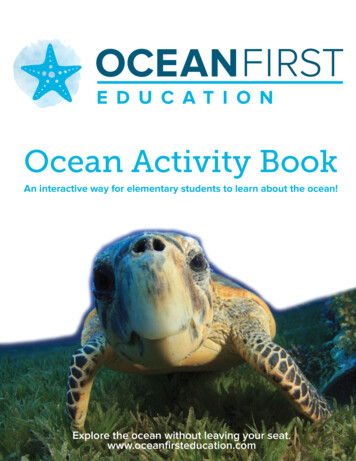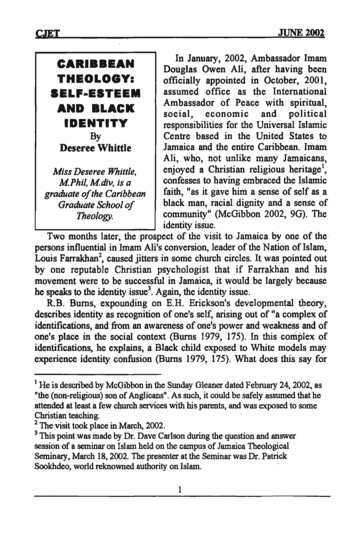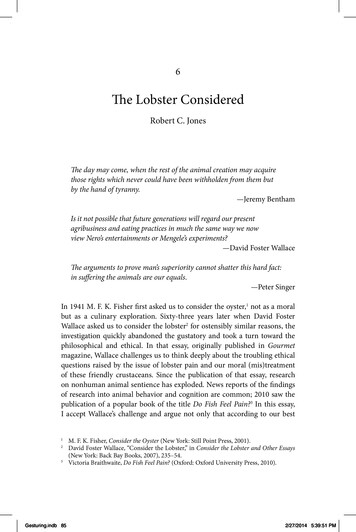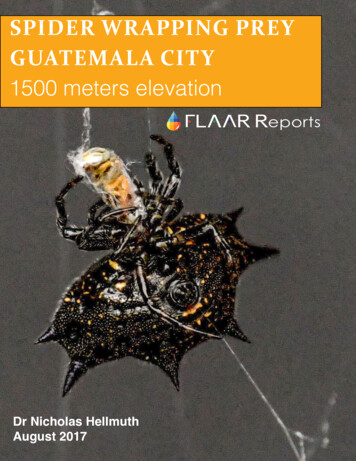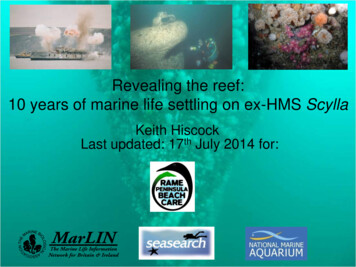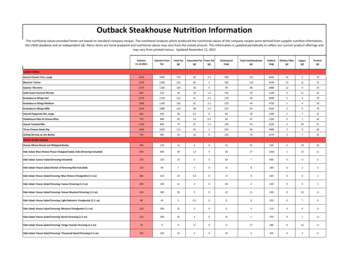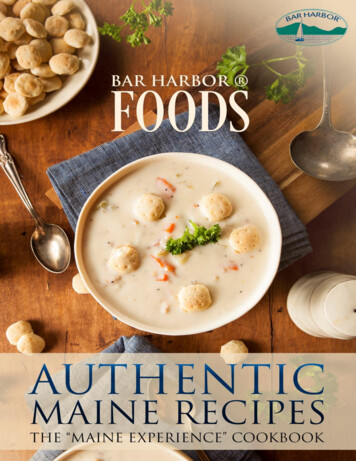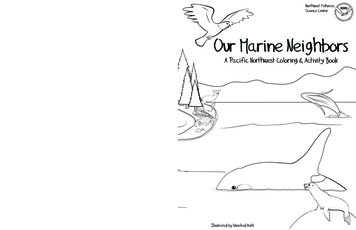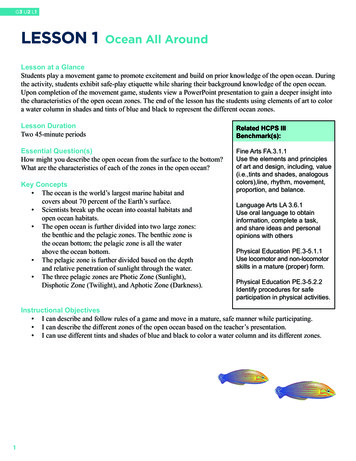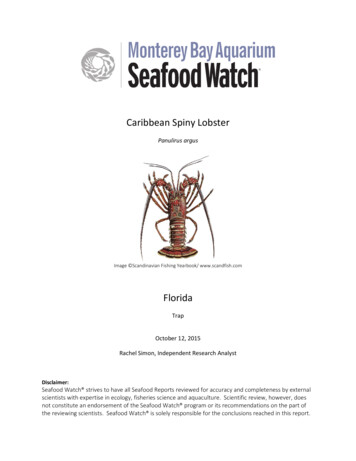
Transcription
Caribbean Spiny LobsterPanulirus argusImage Scandinavian Fishing Yearbook/ www.scandfish.comFloridaTrapOctober 12, 2015Rachel Simon, Independent Research AnalystDisclaimer:Seafood Watch strives to have all Seafood Reports reviewed for accuracy and completeness by externalscientists with expertise in ecology, fisheries science and aquaculture. Scientific review, however, doesnot constitute an endorsement of the Seafood Watch program or its recommendations on the part ofthe reviewing scientists. Seafood Watch is solely responsible for the conclusions reached in this report.
2About Seafood Watch Monterey Bay Aquarium’s Seafood Watch program evaluates the ecological sustainability ofwild-caught and farmed seafood commonly found in the United States marketplace. SeafoodWatch defines sustainable seafood as originating from sources, whether wild-caught orfarmed, which can maintain or increase production in the long-term without jeopardizing thestructure or function of affected ecosystems. Seafood Watch makes its science-basedrecommendations available to the public in the form of regional pocket guides that can bedownloaded from www.seafoodwatch.org. The program’s goals are to raise awareness ofimportant ocean conservation issues and empower seafood consumers and businesses to makechoices for healthy oceans.Each sustainability recommendation on the regional pocket guides is supported by a SeafoodReport. Each report synthesizes and analyzes the most current ecological, fisheries andecosystem science on a species, then evaluates this information against the program’sconservation ethic to arrive at a recommendation of “Best Choices,” “Good Alternatives” or“Avoid.” The detailed evaluation methodology is available upon request. In producing theSeafood Reports, Seafood Watch seeks out research published in academic, peer-reviewedjournals whenever possible. Other sources of information include government technicalpublications, fishery management plans and supporting documents, and other scientific reviewsof ecological sustainability. Seafood Watch Research Analysts also communicate regularlywith ecologists, fisheries and aquaculture scientists, and members of industry and conservationorganizations when evaluating fisheries and aquaculture practices. Capture fisheries andaquaculture practices are highly dynamic; as the scientific information on each species changes,Seafood Watch’s sustainability recommendations and the underlying Seafood Reports will beupdated to reflect these changes.Parties interested in capture fisheries, aquaculture practices and the sustainability of oceanecosystems are welcome to use Seafood Reports in any way they find useful. For moreinformation about Seafood Watch and Seafood Reports, please contact the Seafood Watch program at Monterey Bay Aquarium by calling 1-877-229-9990.
3Guiding PrinciplesSeafood Watch defines sustainable seafood as originating from sources, whether fished 1 orfarmed, that can maintain or increase production in the long-term without jeopardizing thestructure or function of affected ecosystems.Based on this principle, Seafood Watch had developed four sustainability criteria for evaluatingwild-catch fisheries for consumers and businesses. These criteria are: How does fishing affect the species under assessment? How does the fishing affect other, target and non-target species? How effective is the fishery’s management? How does the fishing affect habitats and the stability of the ecosystem?Each criterion includes: Factors to evaluate and score Guidelines for integrating these factors to produce a numerical score and ratingOnce a rating has been assigned to each criterion, we develop an overall recommendation.Criteria ratings and the overall recommendation are color coded to correspond to thecategories on the Seafood Watch pocket guide and the Safina Center’s online guide:Best Choice/Green: Are well managed and caught in ways that cause little harm to habitats orother wildlife.Good Alternative/Yellow: Buy, but be aware there are concerns with how they’re caught.Avoid/Red: Take a pass on these for now. These items are overfished or caught in ways thatharm other marine life or the environment.1 “Fish” is used throughout this document to refer to finfish, shellfish and other invertebrates.
4SummaryThe spiny lobster is a commercially and recreationally fished marine invertebrate. There aremany species of spiny lobster located throughout the tropical and subtropical areas of theworld. This report will provide information and recommendations for the Caribbean spinylobster (Panulirus argus) fished with traps in and around Florida, in both state and federalwaters. The Caribbean spiny lobster is found and fished along the coast of Florida, within theGulf of Mexico, the Caribbean Sea, and the along the coast of South America through Brazil. Itshould be noted the Caribbean spiny lobster may be composed of genetically distinct stocks inthe Caribbean Sea and along the Brazilian coast, although lobsters with genetic markers fromeach of these stocks are found within the entire range indicating mixing.The spiny lobster is moderately vulnerable to fishing pressure. They tend to mature fairlyquickly (between 1 and 2 years at the earliest, though size is a better determination), comparedto their life span (estimated between 10 and 30 years). Mature spiny lobsters spawn at leastonce a year and females can produce a maximum of 830 eggs per gram of body mass, whichcan disperse widely. Comprehensive stock assessments were conducted in 2005 and 2010 andthe Florida fishery seems to be experiencing steady landing rates. However, the stock status ofCaribbean spiny lobster is essentially unknown. Fishing mortality follows a similar pattern tothat of stock abundance, but is also essentially unknown as a result of the recruitmentdependence of lobster fished in other Caribbean and Central American countries. The impactof the fishery on spiny lobster in Florida is deemed moderate.The most common non-targeted species caught in the lobster fisheries include white grunts(Haemulon plumierii) and stone crabs (Menippe spp.). Various other finfish and invertebrates,such as grouper, hogfish, snapper, hermit crabs, arrow crabs and spider crabs comprise nomore than 5% of the catch. White grunts and stone crabs are assessed under criterion 2, buthave low inherent vulnerability and are not overfished or undergoing overfishing.It should also be noted that the 8%–15% discard rate includes captured invertebrates that aremost often returned to the water alive, but does not include the bait used. Studies from otherlobster fisheries globally have shown that the volume of bait used regularly exceeds the volumeof the target species landed, but that is not the case in the Florida lobster fishery. In the Floridalobster fishery, live, undersized (and sometimes legal sized) lobster are used as an attractant forother lobsters in lieu of baiting the traps. Strips of salted cowhide are used as baitsecondarily. Fish carcasses may be used at times but is not preferred for bait use due to therapid disintegration within the traps. The use of undersized lobsters as attractants does exertup to 10% “bycatch” mortality. However, this is considered in the score for the stock status.
5Management of the spiny lobster fishery in Florida has been effective at maintaining a relativelystable population over time. Lobster populations are protected through the use of closedareas, specific seasons to protect breeding females, gear restrictions, and limitations on thenumber of traps. The stock has been assessed fairly regularly, but latest assessments haveidentified a lack of confidence due to the reliance on recruitment from other populations in theCaribbean. Impacts on other species have been fairly limited to date. Enforcement of existingregulations has increased in recent years and results in punishments for illegal fishing andpoaching. Overall, the spiny lobster fishery is a well-managed fishery.The commercial spiny lobster fishery in Florida is almost entirely trap based (there is somecommercial diving, however this is not considered within the scope of this report). Traps resultin some damage to the benthic habitat but both state and federal waters off the coast ofFlorida maintain networks of various representative habitats protected from fishing. There are60 areas closed for the specific reason of protecting Acropora coral species. The ecosystemimpacts from the trap fishery are moderate.Table of Conservation Concerns and Overall RecommendationsStock / FisheryCaribbean spiny lobsterFlorida Atlantic - TrapImpacts onthe StockYellow(2.64)Impacts on Management Habitat andother Spp.EcosystemYellowGreen (3.87) Yellow (2.74)(3.15)OverallRecommendationGood Alternative(3.066)Scoring GuideScores range from zero to five where zero indicates very poor performance and five indicatesthe fishing operations have no significant impact.Final Score geometric mean of the four Scores (Criterion 1, Criterion 2, Criterion 3, Criterion4). Best Choice/Green Final Score 3.2, and no Red Criteria, and no Critical scores Good Alternative/Yellow Final score 2.2-3.2, and neither Harvest Strategy (Factor 3.1)nor Bycatch Management Strategy (Factor 3.2) are Very High Concern 2, and no more thanone Red Criterion, and no Critical scoresAvoid/Red Final Score 2.2, or either Harvest Strategy (Factor 3.1) or BycatchManagement Strategy (Factor 3.2) is Very High Concern or two or more Red Criteria, or oneor more Critical scores. Because effective management is an essential component of sustainable fisheries, Seafood Watch issues an Avoidrecommendation for any fishery scored as a Very High Concern for either factor under Management (Criterion 3).2
6Table of ContentsAbout Seafood Watch . 2Guiding Principles . 3Introduction . 7Assessment . 11Criterion 1: Stock for which you want a recommendation. 11Criterion 2: Impacts on Other Species . 15Criterion 3: Management effectiveness . 21Criterion 4: Impacts on the habitat and ecosystem. 28Acknowledgements. 32References . 33
7IntroductionScope of the Analysis and Ensuing RecommendationThe spiny lobster is a commercially fished marine invertebrate. There are several distinctspecies of spiny lobster located in various areas of the world. This report will provideinformation and recommendations for the Caribbean spiny lobster (Panulirus argus) fished withtraps in and around Florida, in both state and federal waters. The Caribbean spiny lobster isfound and fished along the coast of Florida, within the Gulf of Mexico, the Caribbean Sea, andthe along the coast of South America through Brazil (Holthuis 1991). It should be noted theCaribbean spiny lobster may be composed of several genetically distinct stocks in the CaribbeanSea and along the Brazilian coast, although lobsters with genetic markers from each of thesestocks are found within the entire range indicating mixing (Ehrhardt 2005)(SEDAR 2010).Figure 1. Distribution of P. argus. Figure from Holthuis 1991
8Overview of the Species and Management BodiesThe spiny lobster, of the genus Panulirus,contains approximately 20 different species occurringworldwide in tropical and subtropical waters (Pollack 1995). Spiny lobster can be easilydistinguished by the long, spiny antennae and by the lack of claws on the first four pairs of legs(Holthuis 1991). Spiny lobsters are typically found at depths from 0 to 90 meters, dependingupon the species (Holthuis 1991). Juvenile lobsters usually spend their first few years innearshore surf grass beds, clumps of red macroalgae and other areas with hard bottomsubstrate, while adults favor rocky substrates and reefs and areas that provide protection(Bertelsen et al. 2009)(GMFMC & SAFMC 2011b). Spiny lobsters tend to be nocturnal andmigrate among depths, and generally moving deeper in winter months (Holthuis 1991).Several different species of spiny lobster support commercial fisheries worldwide. Aspreviously mentioned, this report covers the Caribbean spiny lobster trap fishery in and aroundthe state of Florida. The state of Florida also allows diving and the use of bully nets tocommercially harvest spiny lobster. However, the estimated take by bully nets and diving is 1%and 6% respectively and these methods have little impact on additional species and the benthichabitat. As such, these methods are not analyzed in this report.In Florida state waters, the Caribbean spiny lobster fishery is managed by the Florida Fish andWildlife Conservation Commission (FFWCC 2011). In federal waters, the spiny lobster ismanaged by the regional fishery management councils. Spiny lobster is regulated under afishery management plan (FMP) through the Gulf of Mexico and South Atlantic FisheryManagement Councils (GMFMC and SAFMC) (GMFMC & SAFMC 2012). Although themanagement councils encompass the federal economic exclusive zones along the states ofNorth Carolina, South Carolina, and Georgia, Texas, Louisiana, Mississippi, and Alabama, thereare currently no directed commercial spiny lobster fisheries in those states (NMFS2009). Florida state regulations and the federal FMP are typically in line with one another. Keymeasures include a minimum size (3 inches carapace length), a 4-month closed season duringthe months of greatest reproductive activity, a prohibition on the take of egg-bearing females,as well as various gear restrictions and other measures designed to reduce discard and protecthabitat (SEDAR 2010). In 1992, Florida adopted regulations instituting the Lobster TrapCertificate Program to reduce the number of traps in the fishery (Matthews and Williams2000). The FMP was implemented in 1982 and has been amended several times over theyears. A recent amendment, Amendment 10, became effective January 2012 and removedsmoothtail spiny lobster, spotted spiny lobster, Spanish slipper lobster, and ridged slipperlobster from the FMP, established an annual catch limit (ACL) and accountability measures,revised permit requirements and conditions for landing, modified regulations for the use ofundersize attractants, and authorized removal of derelict traps (Federal Register 2011)(NMFS
92011). Another amendment, Amendment 11, implemented in April 2012, closed 60 specificareas to protect Acropora coral species.Production StatisticsLandings from the Caribbean spiny lobster in the United States have varied over time, but thelast ten years have oscillated around 2,000 metric tons, though 2010 landings increased toroughly 2,600 metric tons (NMFS 2012b). Changes in fishing pressure and patterns may beresponsible for some of the fluctuation of landings over time. For the last ten years, Florida wasresponsible for all Caribbean spiny lobster landings in the United States. The United Statesimports spiny lobster from countries around the world, including the Caribbean spiny lobsterfrom several countries in the Caribbean, Central and South American. The landings from Braziland the Bahamas are around 7,000 tons (FAO 2009). The landings from Belize have been fairlyconsistent around 600 tons (FAO 2009). Honduras and Nicaragua each saw a reduction incapture around the year 2000 and again recently. Landings from 2009 for Honduras andNicaragua were 3,039 and 4,186 metric tons, respectively (FAO 2009).Figure 2. US Landings of Caribbean spiny lobster from 1950-2010, in metric tons. Figure compiled from data inNMFS 2012b.Importance to the US/North American MarketSpiny lobsters are fished throughout the Caribbean and Mexico and imported in large numbersto the United States. The combined western Atlantic landings of the species were
10approximately 28,122 metric tons in 2008, while the US landings of spiny lobster comprised5.6% of the regional landings (SEDAR 2010).Common and Market NamesSpiny lobsters, in general, are also known as rock lobsters. While known as spiny lobster, thereare other less commonly used nomenclatures. The Caribbean spiny lobster is also known asBermuda spiny lobster, common spiny lobster, crawfish, crayfish, Florida (spiny) lobster, WestIndian langouste and West Indian spiny lobster (Holthuis 1991)(NOAA 2011).Primary Product FormsThe Caribbean spiny lobster is marketed whole – and sold live, cooked, and/or frozen. Tails aresold fresh and frozen.
11AssessmentThis section assesses the sustainability of the fishery(s) relative to the Seafood Watch Criteriafor Fisheries, available at http://www.seafoodwatch.org.Criterion 1: Stock for which you want a recommendationThis criterion evaluates the impact of fishing mortality on the species, given its currentabundance. The inherent vulnerability to fishing rating influences how abundance is scored,when abundance is unknown. The final Criterion 1 score is determined by taking the geometricmean of the abundance and fishing mortality scores. The Criterion 1 rating is determined asfollows: Score 3.2 Green or Low ConcernScore 2.2 and 3.2 Yellow or Moderate ConcernScore 2.2 Red or High ConcernRating is Critical if Factor 1.3 (Fishing Mortality) is Critical.Criterion 1 SummaryCARIBBEAN SPINY LOBSTERRegion / MethodFlorida AtlanticTrapInherentAbundance FishingSubscoreVulnerabilityMortality2.00:Medium 3.00:Moderate 2.33:Moderate Yellow (2.644)ConcernConcernCriterion 1 AssessmentCARIBBEAN SPINY LOBSTERFactor 1.1 - Inherent VulnerabilityScoring Guidelines Low—The FishBase vulnerability score for species is 0-35, OR species exhibits life historycharacteristics that make it resilient to fishing, (e.g., early maturing).Medium—The FishBase vulnerability score for species is 36-55, OR species exhibits lifehistory characteristics that make it neither particularly vulnerable nor resilient to fishing,(e.g., moderate age at sexual maturity (5-15 years), moderate maximum age (10-25 years),moderate maximum size, and middle of food chain).
12 High—The FishBase vulnerability score for species is 56-100, OR species exhibits life historycharacteristics that make is particularly vulnerable to fishing, (e.g., long-lived ( 25 years),late maturing ( 15 years), low reproduction rate, large body size, and top-predator).Note: The FishBase vulnerability scores is an index of the inherent vulnerability of marinefishes to fishing based on life history parameters: maximum length, age at first maturity,longevity, growth rate, natural mortality rate, fecundity, spatial behaviors (e.g., schooling,aggregating for breeding, or consistently returning to the same sites for feeding orreproduction) and geographic range.Florida Atlantic, TrapMediumAccording to the Seafood Watch PSA analysis, Caribbean spiny lobster appears to be of Mediumvulnerability.RationaleTable 1. Inherent vulnerability of the Caribbean spiny lobsterFactor 1.2 - AbundanceScoring Guidelines 5 (Very Low Concern)—Strong evidence exists that the population is above targetabundance level (e.g., biomass at maximum sustainable yield, BMSY) or near virgin biomass.4 (Low Concern)—Population may be below target abundance level, but it is considered notoverfished.3 (Moderate Concern) —Abundance level is unknown and the species has a low or mediuminherent vulnerability to fishing.2 (High Concern)—Population is overfished, depleted, or a species of concern, OR abundanceis unknown and the species has a high inherent vulnerability to fishing.
13 1 (Very High Concern)—Population is listed as threatened or endangered.Florida Atlantic, TrapModerate ConcernThe biomass for spiny lobster in Florida is considered fairly stable, but due to recent reviews of existingmodels the stock status is considered unknown. It is likely the entire Caribbean spiny lobsterstatus/population is unknown due to the recruitment variability in the region and that populations maybe locally overfished/depleted in other areas of the Caribbean (Ehrhardt 2000). As a result, we haverated this factor Moderate Concern.RationaleRecent reviews of the stock assessments for spiny lobster in the Southeastern United States have showna decreasing biomass but have ultimately rejected the latest model results and declared the stock statusas unknown due to the uncertainties related to dependence upon external recruitment from theCaribbean populations (SEDAR 2010). Although catch data are available, stock assessments have notbeen performed for Honduras or Nicaragua since 1999 (pers. comm. Phillips 2012). The 2006assessment for the Brazilian stock indicated that biomass has decreased (Ehrhardt and Negreiros Aragão2006). There are also reports that local Florida spawning stock biomass, estimated from an agestructured sequential population analysis, has decreased since 1988 (Ehrhardt and Fitchett 2010). Theoverall uncertainties which have led regional management to reject the latest stock assessment resultsin an unknown stock status.Figure 3. Biomass of Caribbean spiny lobster in southeastern US. Figure from SEDAR 2010.
14Factor 1.3 - Fishing MortalityScoring Guidelines 5 (Very Low Concern)—Highly likely that fishing mortality is below a sustainable level (e.g.,below fishing mortality at maximum sustainable yield, FMSY), OR fishery does not targetspecies and its contribution to the mortality of species is negligible ( 5% of a sustainablelevel of fishing mortality).3.67 (Low Concern)—Probable ( 50%) chance that fishing mortality is at or below asustainable level, but some uncertainty exists, OR fishery does not target species and doesnot adversely affect species, but its contribution to mortality is not negligible, OR fishingmortality is unknown, but the population is healthy and the species has a low susceptibilityto the fishery (low chance of being caught).2.33 (Moderate Concern)—Fishing mortality is fluctuating around sustainable levels, ORfishing mortality is unknown and species has a moderate-high susceptibility to the fisheryand, if species is depleted, reasonable management is in place.1 (High Concern)—Overfishing is occurring, but management is in place to curtailoverfishing, OR fishing mortality is unknown, species is depleted, and no management is inplace.0 (Critical)—Overfishing is known to be occurring and no reasonable management is in placeto curtail overfishing.Florida Atlantic, TrapModerate ConcernThe latest review of the spiny lobster stock assessment for the southeastern US has established the Fmsyas unknown because long-term productivity cannot be estimated without further understanding ofrecruitment levels of spawning stock (SEDAR 2010). There is also a lack of data for the spiny lobsterfisheries in other countries (FAO 2003). As a result, we have rated this factor Moderate Concern.
15Criterion 2: Impacts on Other SpeciesAll main retained and bycatch species in the fishery are evaluated in the same way as thespecies under assessment were evaluated in Criterion 1. Seafood Watch defines bycatch as allfisheries-related mortality or injury to species other than the retained catch. Examples includediscards, endangered or threatened species catch, and ghostfishing. To determine the finalCriterion 2 score, the score for the lowest scoring retained/bycatch species is multiplied by thediscard rate score (ranges from 0-1), which evaluates the amount of non-retained catch(discards) and bait use relative to the retained catch. The Criterion 2 rating is determined asfollows: Score 3.2 Green or Low ConcernScore 2.2 and 3.2 Yellow or Moderate ConcernScore 2.2 Red or High ConcernRating is Critical if Factor 2.3 (Fishing Mortality) is Critical.Criterion 2 SummaryCaribbean Spiny Lobster: Florida Atlantic, TrapSubscore: 3.318Discard Rate:0.95SpeciesCARIBBEAN SPINY LOBSTERWHITE GRUNTSTONE CRABS: GULF OF MEXICOC2 rateConcernLow3.00:ModerateConcernLow4.00: n3.67: LowConcernSubscore3.67: LowConcern3.8312.6443.318The most common non-targeted species caught in the lobster fisheries include crabs, such asstone crabs, and additional finfish, such as white grunts. According to Matthews and Donaghue(1997), white grunts and stone crabs dominated bycatch in spiny lobster traps, and aretherefore assessed under Criterion 2. While turtles are entangled occasionally in trap lines,there are very few interactions between turtles and the lobster fishery; a biological opinion onthose interactions found that the spiny lobster fishery has no population level effect onloggerhead, green, hawksbill, leatherback, or Kemp’s ridley sea turtles. Therefore, turtles arenot included in this assessment. Other bycatch species make up less than 5% of the catch andare not considered species of concern. The total discard rate for lobster fisheries is generally
16between 8%–15%.Criterion 2 AssessmentSTONE CRABS: GULF OF MEXICOFactor 2.1 - Inherent VulnerabilityScoring Guidelines (same as Factor 1.1 above)Florida Atlantic, TrapLowUsing the productivity analysis tool in the Seafood Watch criteria, stone crabs have low inherentvulnerability (with a score of 2.5), due to their young age at sexual maturity, their reproductivestrategy and their moderate lifespan.RationaleTable 2. Life history characteristics for stone crab, Menippe spp.Factor 2.2 - AbundanceScoring Guidelines (same as Factor 1.2 above)Florida Atlantic, Trap
17Low ConcernStone crabs are not classified as overfished (NOAA 2015). Stock assessments have been conducted,although coverage could be improved and data are limited (Muller et al 2011). Additionally, there is anabsence of biological reference points leading to uncertainty in the status of the stock.RationalePast assessments of the stone crab fishery have concluded that the resource is not overfished, even inthe face of dramatic increases in the number of traps used in the fishery, though there is evidence thatthe fishery is being recruitment-harvested and fished at a maximum level (Bert 1992)(Muller et al.2006)(Muller et al. 2011).Factor 2.3 - Fishing MortalityScoring Guidelines (same as Factor 1.3 above)Florida Atlantic, TrapLow ConcernThere is no formal metric for fishing mortality, however, observed fishing practices in the spiny lobsterfishery are shown to have minimal impact on bycatch (Matthews and Donaghue 1997); therefore wehave rated this factor Low Concern.Factor 2.4 - Discard RateFlorida Atlantic, Trap20%–40%Total discard rates given in Shester and Micheli (2011) for spiny lobster trap fisheries are presented as15%. Although this study refers to the California spiny lobster (P. interruptus) fishery, rather than theCaribbean spiny lobster, it is possible the rates are quite similar. There is little information about thetotal discard rate in the Caribbean spiny lobster fishery. Most studies to date have been focused oncomparing percentages of bycatch in various types of traps and not the impact to the ecosystem as awhole. However, Matthews et al. (2005) did note that the number of fish that died in traps duringobservations over one season was quite small. Data from Shester and Micheli (2011) include theinvertebrates that are most often returned to the water alive, but does not include the baitused. Studies from other lobster fisheries globally have shown that volumes of bait used regularlyexceed the volume of the target species landed (Harnish & Martin Willison 2009)(Waddington andMeeuwig 2009), but that is not the case in the Florida lobster fishery. The Florida fishery permits the
18use of undersized lobsters (or “shorts”) as attractants in traps (GMFMC & SAFMC 2011b). Strips ofsalted cowhide are used as bait secondarily and fish carcasses may be used at times but is not preferredfor bait use due to the rapid disintegration within the traps (personal communication (Gregory2013). Studies have shown that traps baited with short lobsters catch more lobster than traps baitedwith any other method (Heatwole et al. 1988). Although there are measures in place to reducemortality, the impacts of confinement may result in up to 10% mortality (Matthews 2001)(pers. comm.Matthews 2013). Combined with a conservative estimate of 15% discards from the Shester & Micheli(2011), a total bait use and discard rate of 25% is given.WHITE GRUNTFactor 2.1 - Inherent VulnerabilityScoring Guidelines (same as Factor 1.1 above)Florida Atlantic, TrapLowThe FishBase score for white grunt is 62, which is considered high vulnerability (Froese and Pauly 2014),but using the productivity analysis tool in the Seafood Watch criteria, white grunt have low inherentvulnerability with a score of 2.5, due to their young age at sexual maturity, their reproductivestrategy and their moderate lifespan.Rationale
19Table 3. Life history characteristics for the White grunt, Haemulon plumierii.Factor 2.2 - AbundanceScoring Guidelines (same as Factor 1.2 above)Florida Atlantic, TrapModer
such as grouper, hogfish, snapper, hermit crabs, arrow crabs and spider crabs comprise no more than 5% of the catch. White grunts and stone crabs are assessed under criterion 2, but have low inherent vulnerability and are not overfished or undergoing overfishing.
